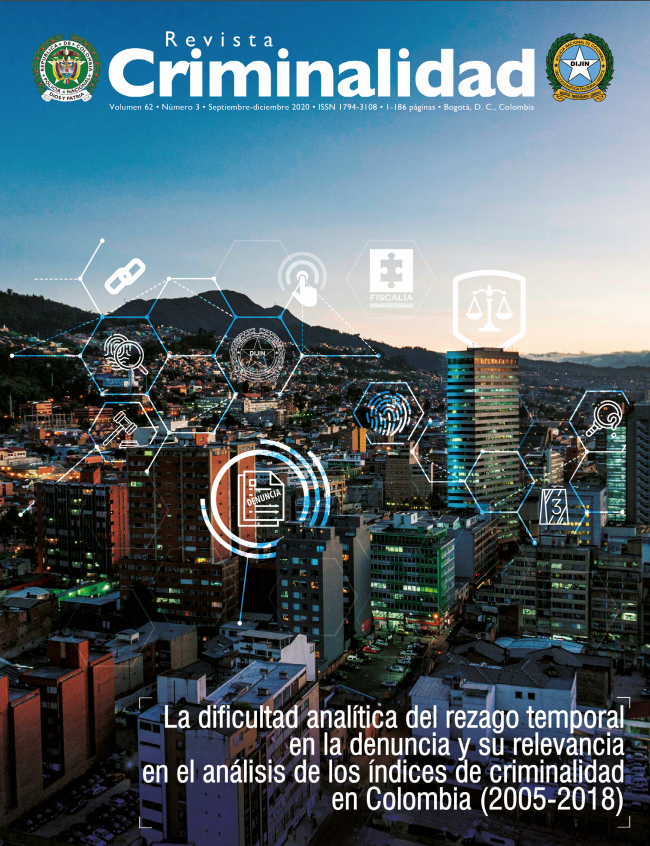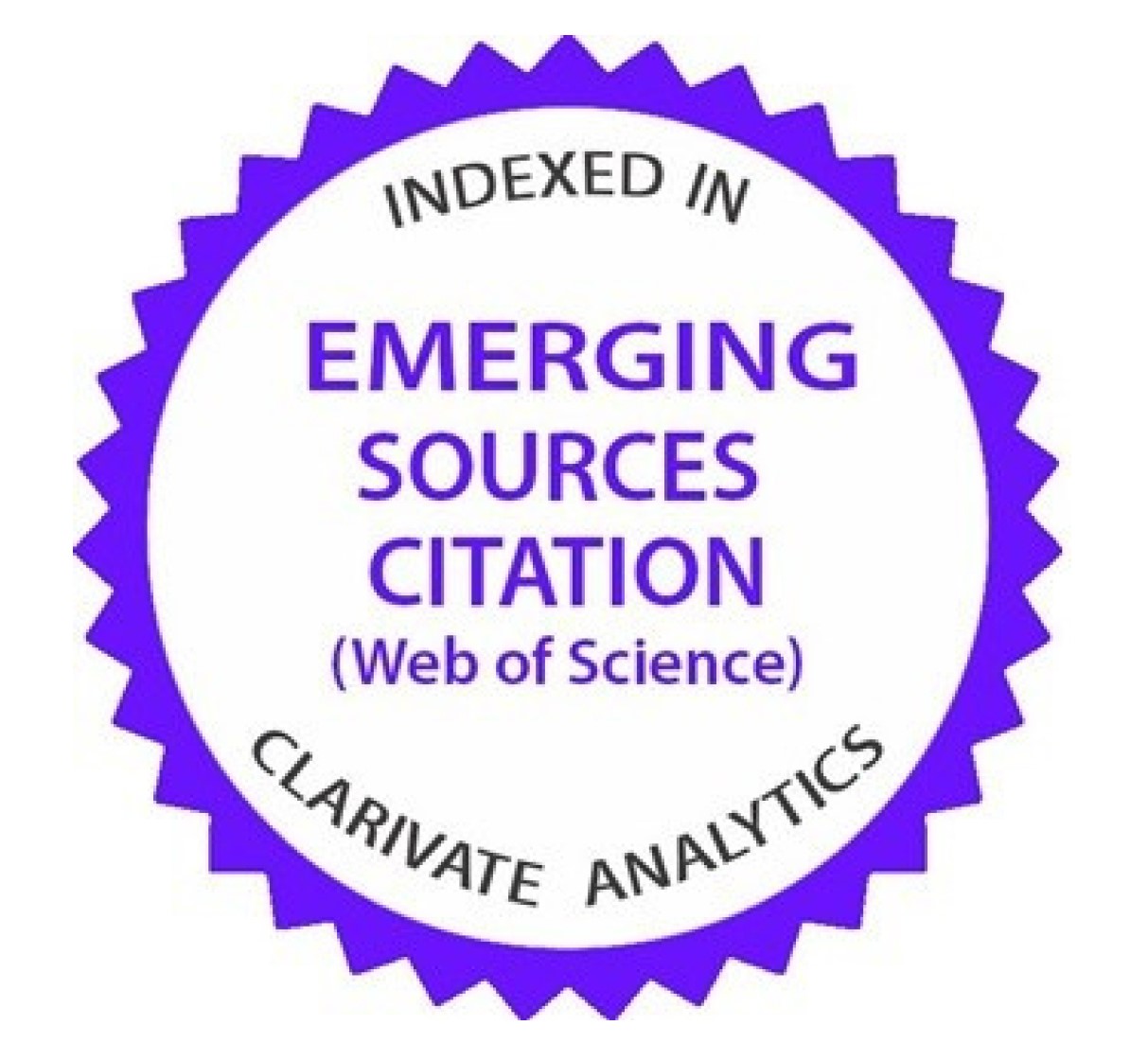Delinquência juvenil na União Europeia após a crise financeira de 2008
DOI:
https://doi.org/10.47741/17943108.218Palavras-chave:
delinquente juvenil, delinquente juvenil, custo econômico, custo econômico, crimes contra o patrimônio, crimes contra o patromônio, deliquente, delinquenteResumo
Este artigo investiga, desde uma abordagem da análise econômica do crime, que papel teve a idade nas taxas de criminalidade após a crise econômica de 2008 para uma amostra de 24 países da União Europeia (UE). Para fazer isso, é estabelecido um modelo de dados em painel com efeitos fixos, com base nos dados do Eurostat, e é realizada uma análise empírica dos fatores que influenciam a delinquência na UE, adoptando o método dos mínimos quadrados. Os resultados coincidem com a literatura existente: jovens entre 15 e 19 anos têm maior probabilidade de cometer crimes e, à medida que envelhecem, sua atividade criminal diminui. Esta pesquisa é inédita e contribui com novos resultados para a controvérsia acadêmica sobre a influência do estado da economia na delinquência, pois confirma que a deterioração das condições econômicas é um fator que potencializa a delinquência na União Europeia, especialmente os crimes contra o patrimônio.
Downloads
Referências
Altheimer, I. (2008). Social support, ethnic heterogeneity and homicide: A cross-national approach. Journal of Criminal Justice, 36 (2), 103-114. https://doi.org/10.1016/j.jcrimjus.2008.02.002
Altindag, D. T. (2012). Crime and unemployment: evidence from Europe”. International Review of Law and Economics, 32 (1), 145-157. https://doi.org/10.1016/j.irle.2011.10.003
Anderson, M. (2014). In school and out of trouble? The minimum dropout age and juvenile crime. Review of Economic and Statistics, 96 (2), 318-331. https://doi.org/10.1162/REST_a_00360
Andresen, M. A. (2013). Unemployment, business cycles, crime, and the Canadian provinces. Journal of Criminal Justice, 41 (4), 220-227. https://doi.org/10.1016/j.jcrimjus.2013.05.006
Andresen, M. (2015). Unemployment, GDP, and Crime: The Importance of Multiple Measurements of the Economy. Canadian Journal of Criminology and Criminal Justice, 57 (1), 35-58. https://doi.org/10.3138/CJCCJ.2013.E37
Arellano, M. (1987). Computing robust standard errors for within-groups estimators. Oxford Bulletin of Economics and Statistics, 49 (4), 431-434. https://doi.org/10.1111/j.1468-0084.1987.mp49004006.x
Aslund, O., Grönqvist, H., Hall, C. y Vlachos, J. (2018). Education and criminal behavior: Insights from an expansion of upper secondary school. Labour Economics, 52 (1), 178-192. https://doi.org/10.1016/j.labeco.2017.11.007
Baltagi, B.H. (2005). Econometric Analysis of Panel Data. (3rd Edition). New York:, John Wiley & Sons Inc., New York.
Blau, J. y Blau, P. M. (1982). The cost of inequality: Metropolitan structure and violent crime. American Sociological Review, 47 (1), 114-128. https://doi.org/10.2307/2095046
Buonanno, P. y Montolio, M. (2008). Identifying the socioeconomic and demographic determinants of crime across Spanish provinces. International Review of Law and Economics, 28 (2), 89-97. https://doi.org/10.1016/j.irle.2008.02.005
Buonanno, P. y Montolio, M. (2009). Juvenile crime in Spain. Applied Economics Letters, 16(5), 495- 500. https://doi.org/10.1080/13504850601018684
Becker, G. (1968). Crime and punishment: an economic approach. Journal of Political Economy, 76 (2), 169-217. https://doi.org/10.1086/259394
Billari, F. y Liefbroer, L. (2010). Towards a new pattern of transition to adulthood? Advances in Life Course Research, 15 (2-3), 59-75. https://doi.org/10.1016/j.alcr.2010.10.003
Bindler, A. y Hjalmarsson, R. (2017). Prisons, recidivism and the age-crime profile. Economics Letters, 152 (1), 46-49. https://doi.org/10.1016/j.econlet.2017.01.002
Cantor, D. y Land, K. C. (1985). Unemployment and crime rates in the post-World War II United States: a theoretical and empirical analysis. American Sociological Review, 50 (3), 317-332. https://doi.org/10.2307/2095542
Campistol, C. y Aebi, M. (2017). Are juvenile criminal justice statistics comparable across countries? A study of the data available in 45 European nations. European Journal on Criminal Policy and Research, 24 (1), 55-78. https://doi.org/10.1007/s10610-017-9345-2
Carmichael, F. y Ward, R. (2001). Male Unemployment and Crime in England and Wales. Economics Letters, 73 (1), 111-115. https://doi.org/10.1016/S0165-1765(01)00466-9
Fajnzylber, P., Lederman, D. y Loayza, N. (2002). Inequality and violent crime. Journal of Law and Economics, 45(1), 1-40. https://doi.org/10.1086/338347
Farrington, D. (1986). Age and crime. Crime and Justice, 7 (1), 189-250. https://doi.org/10.1086/449114
Fernández-Molina, E. y Bartolomé Gutiérrez, R. (2018). Juvenile crime drop: What is happening with youth in Spain and why? European Journal of Criminology, 17 (3), 1-26. https://doi.org/10.1177/1477370818792383
Fougère, D., Kramarz, F. y Pouget, J. (2009). Youth Unemployment and Crime in France. Journal of European Economic Association, 7 (5),: 909-938. https://doi.org/10.1162/JEEA.2009.7.5.909
Glaeser, E. L. y Sacerdote, B. (1999). Why is there more crime in cities? Journal of Political Economy, 107 (S6), S225-258. https://doi.org/10.1086/250109
Grogger, J. (1998). Market wages and youth crime. Journal Labor Economics, 16 (4), 756-791. https://doi.org/10.1086/209905
Hsiao, C. (2003). Analysis of Panel Data. Cambridge: Cambridge. University Press., Cambridge. https://doi.org/10.1017/CBO9780511754203
Hsiao, C. y Sun, B.H. (2000). To Pool or Not to Pool Panel Data, Panel Data Econometrics: Future Directions, (Papers in Honor of Professor Pietro Balestra,, edited by J. Krishnakumar and E. Ronchetti). Amsterdam: North Holland.
Jacob, B. y Lefgren, L. (2003). Are idle hands the devil’s workshop? Incapacitation, concentration and juvenile crime. American Economic Review, 93 (5), 1560-1577. https://doi.org/10.1257/000282803322655446
Jacobs, D. y Richardson, A. M. (2008), Economic Inequality and Homicide in the Developed Nations From 1975 to 1995. Homicide Studies, 12(1), 28-45. https://doi.org/10.1177/1088767907311849
Janko, Z. y Popli, G. (2015). Examining the link between crime and unemployment: a time-series analysis for Canada. Applied Economics, 47(37), 4007-4019. https://doi.org/10.1080/00036846.2015.1023942
Kennedy, L. W. y Forde, D. R. (1990). Routine activities and crime: An analysis of victimization in Canada. Criminology, 28 (1), 137-152. https://doi.org/10.1111/j.1745-9125.1990.tb01321.x
Lafree, G. (1999). A summary and review of crossnational comparative studies of homicide, in M. Smith and M. Zahn (Eds.), Homicide: A sourcebook of social research. Thousand Oaks, CA: Sage.
Landersø, R., Nielsen, H. y Simonsen, M. (2017). School Starting Age and the Crime-age Profile. The Economic Journal, 127 (602), 1096-1118. https://doi.org/10.1111/ecoj.12325
Lin, M. J. (2007). Does democracy increase crime? The evidence from international data. Journal of Comparative Economics, 35(1), 467-483. https://doi.org/10.1016/j.jce.2007.06.001
Lin, M. J. (2008). Does Unemployment Increase Crime? Evidence from US Data 1974-2000. Journal of Human Resources, 43 (2), 413-436. https://doi.org/10.1353/jhr.2008.0022
Loeber, R., Farrington, D. y Redondo Illescas, S. (2011). La transición desde la delincuencia juvenil a la delincuencia adulta. Revista Española de Investigación Criminológica, 1(9), 1-41.
Lochner, L. (2004). Education, work and crime: A human capital approach. International Economic Review, 45 (3), 811-843. https://doi.org/10.1111/j.0020-6598.2004.00288.x
Lochner, L. y Moretti, M. (2004). The Effect of Education on Crime: Evidence from Prison Inmates, Arrests, and Self-Reports. American Economic Review, 94 (1), 155-180. https://doi.org/10.1257/000282804322970751
Luallen, J. (2006). School’s Out... Forever: A Study of Juvenile Crime, At-Risk Youths and Teacher Strikes. Journal of Urban Economics, 59 (1), 75-103. https://doi.org/10.1016/j.jue.2005.09.002
McCall, P. y Nieuwbeerta, P. (2007). Structural Covariates of Homicide Rates. A European City Cross-National Comparative Analysis. Homicides Studies, 11 (2), 167-188. https://doi.org/10.1177/1088767907304072
Montero Soler, A. y Torres López, J. (1998). La economía del delito y de las penas. Un análisis crítico. España: Comares, España.
Min, I. S. y Choi, P. S. (2009). Panel data analysis. Seoul, South Korea: The Korea Association of STATA.
Öster, A. y Agell, J. (2007). Crime and unemployment in turbulent times. Journal of the European Economic Association, 5 (4), 752-775. https://doi.org/10.1162/JEEA.2007.5.4.752
Ouimet, M. (2012). A World of Homicides: The Effect of Economic Development, Income Inequality, and Excess Infant Mortality on the Homicide Rate for 165 Countries in 2010. Homicide Studies, 16 (3), 238-258. https://doi.org/10.1177/1088767912442500
Phillips, J. y Land, K. (2012). The Link between Unemployment and Crime Rate Fluctuations: An Analysis at the County, State, and National Levels. Social Science Research, 41 (3), 681-694. https://doi.org/10.1016/j.ssresearch.2012.01.001
Raphael, S. y Winter-Ebmer, R. (2001). Identifying the effect of unemployment on crime. Journal of Law and Economics, 44 (1), 259-284. https://doi.org/10.1086/320275
Roberts, A. y Willits, D. (2015). Income Inequality and Homicide in the United States: Consistency Across Different Income Inequality Measures and Disaggregated Homicide Types. Homicide Studies, 19 (1), 28-57. https://doi.org/10.1177/1088767914557811
Saridakis, G. y Spengler, H. (2012). Crime, deterrence and unemployment in Greece: A panel data approach. The Social Science Journal, 49 (2), 167-174. https://doi.org/10.1016/j.soscij.2011.08.005
Strat, V.A., Davidescu, A. A., Grosu, R. M. y Zgura, I. D. (2016). Regional Development Fueled by Entrepreneurial Ventures Providing KIBS - Case Study on Romania. Amfiteatru Economic Journal, 18 (41), 55-72.
Wadsworth, T. (2010). Is immigration responsible for the crime drop? An assessment of the influence of immigration on changes in violent crime between 1990 and 2000. Social Science Quarterly, 91(2), 531-553. https://doi.org/10.1111/j.1540-6237.2010.00706.x
Wilkinson, R. (2004). Why Is Violence More Common where Inequality Is Greater? Annals of the New York Academy of Sciences, 1036 (1), 1-12. https://doi.org/10.1196/annals.1330.001
Wilkinson, R. y Pickett, K. (2019). The Inner Level: How More Equal Societies Reduces Stress, Restore Sanity and Improve. Madrid: Capitan Swing: Madrid.
Wirth, L. (1938). Urbanism as a way of life. American Journal of Sociology, 44 (1), 1-24. https://doi.org/10.1086/217913
Witte, A. D. (2002). Crime causation: economic theories., Iin Encyclopedia of Crime and Justice. New York: MacMmillan. Reference USA, New York.
Wooldridge, J.M. (2002). Econometric Analysis of Cross Section and Panel Data. Cambridge, MA: MIT Press., Cambridge, MA.
Wu, D. y Wu, Z. (2012). Crime, inequality and unemployment in England and Wales. Applied Economics, 44 (29), 3765-3775. https://doi.org/10.1080/00036846.2011.581217
Publicado
Como Citar
Edição
Seção
Licença
Licencia creative commons CC BY NC ND https://creativecommons.org/licenses/by-nc-nd/2.0/















